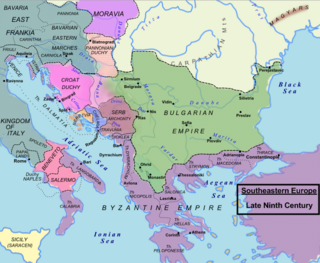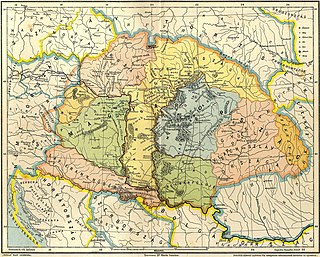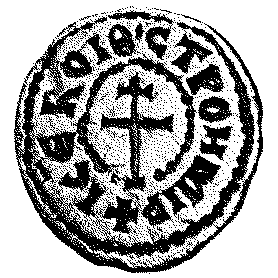 W
WThe Bulgarian-Serbian War of 839–842 was fought between the Bulgarian Khanate and the Serbian Principality. It was the first conflict of the medieval Bulgarian–Serbian Wars.
 W
WThe Bulgarian-Serbian War of 853 was fought between the Bulgarian Khanate and the Serbian Principality. It was the second conflict of the medieval Bulgarian–Serbian Wars.
 W
WThe Serbian Orthodox Church is one of the autocephalous Eastern Orthodox Christian churches. It is the second-oldest Slavic Orthodox Church in the world.
 W
WEparchy of Braničevo is one of the eparchies of the Serbian Orthodox Church, with the seat at Braničevo, Serbia. Since 1994, it is headed by bishop Ignatije Midić.
 W
WEparchy of Raška and Prizren or Eparchy of Raška-Prizren and Kosovo-Metohija, is one of the oldest eparchies of the Serbian Orthodox Church, featuring the seat of the Serbian Orthodox Church, the Serbian Patriarchal Monastery of Peć, as well as Serbian Orthodox Monastery of Visoki Dečani, which together are part of the UNESCO World Heritage sites of Serbia.
 W
WGlad was the ruler of Banat at the time of the Hungarian conquest of the Carpathian Basin around 900 AD, according to the Gesta Hungarorum. The Gesta, which was written by an author known in modern scholarship as Anonymus in the second half of the 12th century or in the early 13th century, is the earliest extant Hungarian chronicle. The Gesta did not refer to the enemies of the conquering Hungarians, who had been mentioned in earlier annals and chronicles, but wrote of a dozen persons, including Glad, who are unknown from other primary sources of the Hungarian Conquest. Therefore, modern historians debate whether Glad was an actual enemy of the conquerors or only a "fictitious person" made up by Anonymus. In Romanian historiography, Glad is described as one of the three Romanian dukes who ruled a historical region of present-day Romania in the early 10th century.
 W
WKanalites were a medieval Slavic tribe settled in the Dalmatian subregion of Konavle, mentioned in the chapter titled "Of the Terbounians and Kanalites and of the country they now dwell in" of the 10th century De Administrando Imperio by Byzantine Emperor Constantine VII. The country, located in near proximity to Travunia, reportedly became desolated during the Pannonian Avars invasion, and its inhabitants are descendants from the unbaptized Serbs, from the time of the Unknown Archon who came from Boiki and claimed the protection of the Emperor Heraclius in the 7th century. However, a closer reading suggests that the Constantine consideration about the population's ethnic identity, like in regard to other near polities, is based on Serbian political rule and also indicate ethnic origin.
 W
WLower Pannonia was an early medieval region, located in the eastern and southern parts of the former Roman province of Pannonia. Division of Pannonia in two main parts was inherited from the Roman terminology, and during the 9th century, the term Lower Pannonia was used to designate those Pannonian regions that were lying from the river Rába to the east and south. From the middle of the 6th to the end of the 8th century, the region was under the domination of Avars, and also inhabited by Slavs, who were under Avarian rule. By the beginning of the 9th century, Avarian state was destroyed and replaced by the supreme rule of the Frankish Empire, which lasted until Magyar conquest.
 W
WThe Principality of Lower Pannonia, also known as the Balaton Principality, was an early medieval Slavic polity, situated in Lower Pannonia, with capital in Blatnograd. The polity was a vassal principality of the Frankish Empire, or according to others, a frontier county of the Eastern Frankish Kingdom. It was initially led by a dux (Pribina) and later by a comes (Kocel, Pribina's son, who was titled as "Count of the Slavs" .. It was one of the early Slavic polities, that emerged during the early medieval period. It was centered in western regions of modern Hungary, but also included some parts of modern Austria, Slovenia, Croatia and Serbia.
 W
WSalan, Dux Salanus or Zalan was, according to the Gesta Hungarorum, a local Bulgarian voivod (duke) who ruled in the 9th century between Danube and Tisa rivers in the south and Carpathians in the north. The capital of his voivodship (duchy) was Titel. The exact border of his duchy is not clear: according to some sources, his duchy included present-day northern Serbia, much of present-day central Hungary, present-day eastern Slovakia and part of present-day western Ukraine and northern Romania, while according to other sources his duchy included only present-day Bačka region of Serbia and Hungary.
 W
WThe Principality of Serbia was one of the early medieval states of the Serbs, located in western regions of Southeastern Europe. It existed from the 8th century up to c. 969-971 and was ruled by the Vlastimirović dynasty. Its first ruler known by name was Višeslav who started ruling around 780. While by that time, starting from the year 681, the Bulgarian state had taken the lands to the east, preparing to conquer Serbia. Vlastimir defeated the Bulgarian army in a three-year-war (839–842), and the two powers lived in peace for some decades. Vlastimir's three sons succeeded in ruling Serbia together, although not for long; Serbia became a key part in the power struggle between the Byzantines and Bulgarians, which also resulted in major dynastic wars for a period of three decades. Central parts of the principality were shortly occupied by the Bulgarian army for three years (924–927), until Serbian prince Časlav was able to liberate the land and unite several Serbian regions, becoming the most powerful ruler of the Vlastimirović dynasty. An important process during this period was the Christianization of the Serbs, the establishment of Christianity as state-religion c. 869, and the founding of the first Serbian eparchy (diocese), the Eparchy of Ras. The principality was annexed by the Byzantines in c. 969-971 and ruled as the Catepanate of Ras. The main information of the history of the principality and Vlastimirović dynasty are recorded in the contemporary historical work De Administrando Imperio.
 W
WThe Vlastimirović was the first Serbian royal dynasty, named after Prince Vlastimir, who was recognized by the Byzantine Empire. The dynasty was established with the Unknown Archont, who ruled during the reign of Emperor Heraclius (610–641). The Vlastimirović dynasty ruled in Serbia until the 960s, when some Serbian lands were annexed by the Byzantine Empire.